Related Research Articles
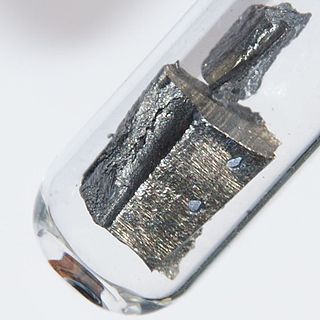
Neodymium is a chemical element; it has symbol Nd and atomic number 60. It is the fourth member of the lanthanide series and is considered to be one of the rare-earth metals. It is a hard, slightly malleable, silvery metal that quickly tarnishes in air and moisture. When oxidized, neodymium reacts quickly producing pink, purple/blue and yellow compounds in the +2, +3 and +4 oxidation states. It is generally regarded as having one of the most complex spectra of the elements. Neodymium was discovered in 1885 by the Austrian chemist Carl Auer von Welsbach, who also discovered praseodymium. It is present in significant quantities in the minerals monazite and bastnäsite. Neodymium is not found naturally in metallic form or unmixed with other lanthanides, and it is usually refined for general use. Neodymium is fairly common—about as common as cobalt, nickel, or copper—and is widely distributed in the Earth's crust. Most of the world's commercial neodymium is mined in China, as is the case with many other rare-earth metals.
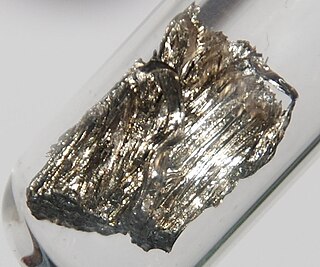
Samarium is a chemical element; it has symbol Sm and atomic number 62. It is a moderately hard silvery metal that slowly oxidizes in air. Being a typical member of the lanthanide series, samarium usually has the oxidation state +3. Compounds of samarium(II) are also known, most notably the monoxide SmO, monochalcogenides SmS, SmSe and SmTe, as well as samarium(II) iodide.

Gadolinite, sometimes known as ytterbite, is a silicate mineral consisting principally of the silicates of cerium, lanthanum, neodymium, yttrium, beryllium, and iron with the formula (Ce,La,Nd,Y)2FeBe2Si2O10. It is called gadolinite-(Ce) or gadolinite-(Y), depending on the prominent composing element. It may contain 35.5% yttria sub-group rare earths, 2.2% ceria earths, as much as to 11.6% BeO, and traces of thorium. It is found in Sweden, Norway, and the US.
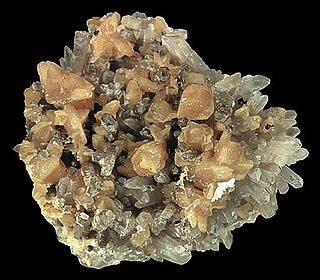
Monazite is a primarily reddish-brown phosphate mineral that contains rare-earth elements. Due to variability in composition, monazite is considered a group of minerals. The most common species of the group is monazite-(Ce), that is, the cerium-dominant member of the group. It occurs usually in small isolated crystals. It has a hardness of 5.0 to 5.5 on the Mohs scale of mineral hardness and is relatively dense, about 4.6 to 5.7 g/cm3. There are five different most common species of monazite, depending on the relative amounts of the rare earth elements in the mineral:

The mineral bastnäsite (or bastnaesite) is one of a family of three carbonate-fluoride minerals, which includes bastnäsite-(Ce) with a formula of (Ce, La)CO3F, bastnäsite-(La) with a formula of (La, Ce)CO3F, and bastnäsite-(Y) with a formula of (Y, Ce)CO3F. Some of the bastnäsites contain OH− instead of F− and receive the name of hydroxylbastnasite. Most bastnäsite is bastnäsite-(Ce), and cerium is by far the most common of the rare earths in this class of minerals. Bastnäsite and the phosphate mineral monazite are the two largest sources of cerium and other rare-earth elements.

Samarskite is a radioactive rare earth mineral series which includes samarskite-(Y), with the chemical formula (YFe3+Fe2+U,Th,Ca)2(Nb,Ta)2O8 and samarskite-(Yb), with the chemical formula (YbFe3+)2(Nb,Ta)2O8. The formula for samarskite-(Y) is also given as (Y,Fe3+,U)(Nb,Ta)O4.

Lanthanites are a group of isostructural rare earth element (REE) carbonate minerals. This group comprises the minerals lanthanite-(La), lanthanite-(Ce), and lanthanite-(Nd). This mineral group has the general chemical formula of (REE)2(CO3)3·8(H2O). Lanthanites include La, Ce, and Nd as major elements and often contain subordinate amounts of other REEs including praseodymium (Pr), samarium (Sm), europium (Eu) and dysprosium (Dy). The lanthanite crystal structure consists of layers of 10-fold coordinated REE-oxygen (O) polyhedra and carbonate (CO32−) groups connected by hydrogen bonds to interlayer water molecules, forming a highly hydrated structure.

Cerite is a complex silicate mineral group containing cerium, formula (Ce,La,Ca)
9(Mg,Fe3+
)(SiO
4)
6(SiO
3OH)(OH)
3. The cerium and lanthanum content varies with the Ce rich species and the La rich species. Analysis of a sample from the Mountain Pass carbonatite gave 35.05% Ce
2O
3 and 30.04% La
2O
3.
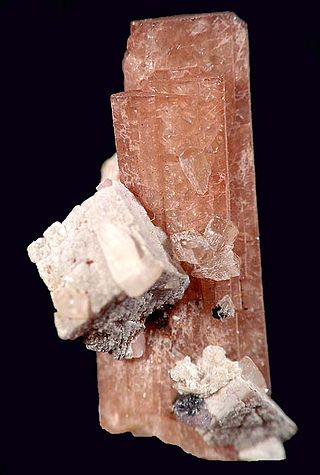
Ancylite is a group of hydrous strontium carbonate minerals containing cerium, lanthanum and minor amounts of other rare-earth elements. The chemical formula is Sr(Ce,La)(CO3)2(OH)·H2O with ancylite-Ce enriched in cerium and ancylite-La in lanthanum.

Dollaseite-(Ce) is a sorosilicate end-member epidote rare-earth mineral which was discovered by Per Geijer (1927) in the Ostanmossa mine, Norberg district, Sweden. Dollaseite-(Ce), although not very well known, is part of a broad epidote group of minerals which are primarily silicates, the most abundant type of minerals on earth. Dollaseite-(Ce) forms as dark-brown subhedral crystals primarily in Swedish mines. With the ideal chemical formula, CaREE3+
Mg
2AlSi
3O
11,(OH)F, dollaseite-(Ce) can be partially identified by its content of the rare earth element cerium.

Stillwellite-(Ce) is a rare-earth boro-silicate mineral with chemical formula (Ce,La,Ca)BSiO5.

Ferrokentbrooksite is a moderately rare mineral of the eudialyte group, with formula Na15Ca6(Fe,Mn)3Zr3NbSi25O73(O,OH,H2O)3(Cl,F,OH)2. The original formula was extended form to show the presence of cyclic silicate groups and presence of silicon at the M4 site, according to the nomenclature of eudialyte group. As suggested by its name, it is the (ferrous) iron analogue of kentbrooksite. When compared to the latter, it is also chlorine-dominant instead of being fluorine-dominant. The original (holotype) material is also relatively enriched in rare earth elements, including cerium and yttrium.
Johnsenite-(Ce) is a very rare mineral of the eudialyte group, with the chemical formula Na12(Ce,La,Sr,Ca,[ ])3Ca6Mn3Zr3WSi(Si9O27)2(Si3O9)2(CO3)O(OH,Cl)2. The original formula was extended to show the presence of both the cyclic silicate groups and silicon at the M4 site, according to the nomenclature of the eudialyte group. It is the third eudialyte-group mineral with essential tungsten, and second with essential rare earth elements. In fact, some niobium substitutes for tungsten in johnsenite-(Ce). Other characteristic feature is the presence of essential carbonate group, shared with carbokentbrooksite, golyshevite, mogovidite and zirsilite-(Ce).

Khomyakovite is an exceedingly rare mineral of the eudialyte group, with formula Na12Sr3Ca6Fe3Zr3W(Si25O73)(O,OH,H2O)3(OH,Cl)2. The original formula was extended to show the presence of both the cyclic silicate groups and M4-site silicon, according to the nomenclature of the eudialyte group. Some niobium substitutes for tungsten in khomyakovite. Khomyakovite is an iron-analogue of manganokhomyakovite, the second mineral being a bit more common. The two minerals are the only group representatives, beside taseqite, with species-defining strontium, although many other members display strontium diadochy. Khomyakovite is the third eudialyte-group mineral with essential tungsten.

Manganokhomyakovite is a very rare mineral of the eudialyte group, with the chemical formula Na12Sr3Ca6Mn3Zr3WSi(Si9O27)2(Si3O9)2O(O,OH,H2O)3(OH,Cl)2. This formula is in extended form, to show the presence of cyclic silicate groups and domination of silicon at the M4 site, basing on the nomenclature of the eudialyte group. Some niobium substitutes for tungsten in khomyakovite. As suggested by its name, manganokhomyakovite is a manganese-analogue of khomyakovite, the latter being more rare. The two minerals are the only group representatives, beside taseqite, with species-defining strontium, although many other members display strontium diadochy. Manganokhomyakovite is the third eudialyte-group mineral with essential tungsten.
Florencite-(Sm) is a very rare mineral of the plumbogummite group (alunite supergroup) with simplified formula SmAl3(PO4)2(OH)6. Samarium in florencite-(Sm) is substituted by other rare earth elements, mostly neodymium. It does not form separate crystals, but is found as zones in florencite-(Ce), which is cerium-dominant member of the plumbogummite group. Florencite-(Sm) is also a samarium-analogue of florencite-(La) (lanthanum-dominant) and waylandite (bismuth-dominant), both being aluminium-rich minerals.

Paratooite-(La) is a complex lanthanum copper(II) calcium sodium carbonate mineral, representing a unique elemental combination among the known minerals. It is a secondary, weathering mineral. There is a heterovalent diadochy substitution of lanthanum by strontium and calcium; also sodium is substituted by calcium in the mineral. Its structure proved to be more difficult to describe within the initial approach. It was later shown to be a superstructure of another rare earth carbonate mineral, carbocernaite. The "-(La)" suffix in the mineral's name is known as Levinson suffix. It refers to the particular element, of a group of elements, that dominates in the particular structural site. As such, the element would show major, dominant occupancy at this particular site.
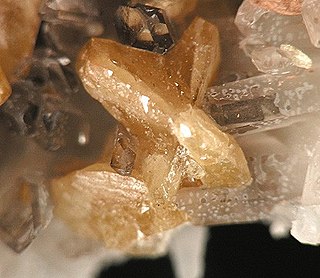
Monazite-(Ce) (CePO4) is the most common representative of the monazite group. It is the cerium-dominant analogue of monazite-(La), monazite-(Nd), and monazite-(Sm). It is also the phosphorus analogue of gasparite-(Ce). The group contains simple rare earth phosphate minerals with the general formula of AXO4, where A = Ce, La, Nd, or Sm (or, rarely, Bi), and X = P or, rarely, As. The A site may also bear Ca and Th.
Monazite-(La) is a relatively rare representative of the monazite group, with lanthanum being the dominant rare earth element in its structure. As such, it is the lanthanum analogue of monazite-(Ce), monazite-(Nd), and monazite-(Sm). It is also the phosphorus analogue of gasparite-(La). The group contains simple rare earth phosphate minerals with the general formula of ATO4, where A = Ce, La, Nd, or Sm (or, rarely, Bi), and B = P or, rarely, As. The A site may also bear Ca and Th.
Monazite-(Nd) is a relatively rare representative of the monazite group, with neodymium being the dominant rare earth element in its structure. This variety of monazite is typically colored bright rose-red. It is the neodymium analogue of monazite-(Ce), monazite-(La), and monazite-(Sm). The group contains simple rare earth phosphate minerals with the general formula of ATO4, where A = Ce, La, Nd, or Sm (or, rarely, Bi), and B = P or, rarely, As. The A site may also bear Ca and Th.
References
- ↑ Warr, L.N. (2021). "IMA–CNMNC approved mineral symbols". Mineralogical Magazine. 85 (3): 291–320. Bibcode:2021MinM...85..291W. doi: 10.1180/mgm.2021.43 . S2CID 235729616.
- ↑ Mindat, Monazite-(Sm), https://www.mindat.org/min-11438.html
- ↑ Mindat, Monazite-(Sm), https://www.mindat.org/min-11438.html
- ↑ Mindat, Monazite Group, https://www.mindat.org/min-29313.html